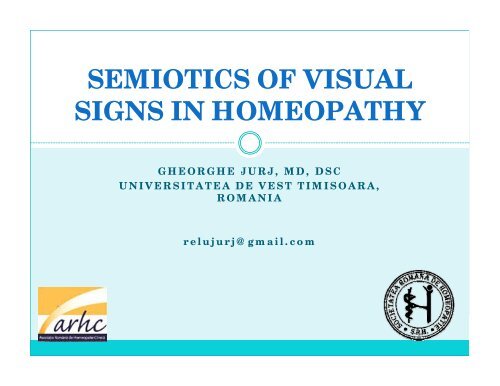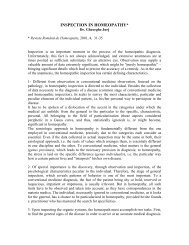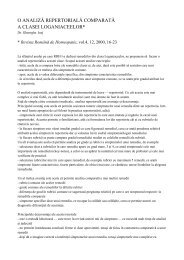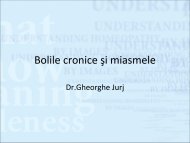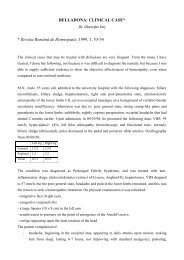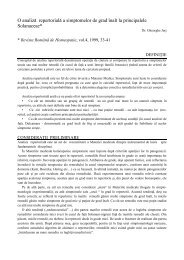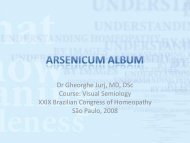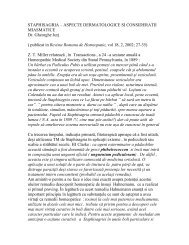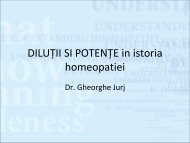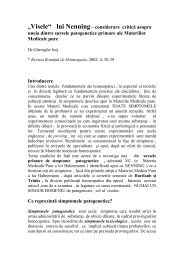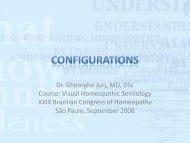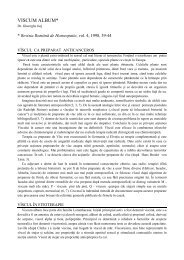SEMIOTICS OF VISUAL SIGNS IN HOMEOPATHY SIGNS IN ...
SEMIOTICS OF VISUAL SIGNS IN HOMEOPATHY SIGNS IN ...
SEMIOTICS OF VISUAL SIGNS IN HOMEOPATHY SIGNS IN ...
Create successful ePaper yourself
Turn your PDF publications into a flip-book with our unique Google optimized e-Paper software.
<strong>SEMIOTICS</strong> <strong>OF</strong> <strong>VISUAL</strong><br />
<strong>SIGNS</strong> <strong>IN</strong> <strong>HOMEOPATHY</strong><br />
GHEORGHE JURJ, MD, DSC<br />
UNIVERSITATEA DE VEST TIMISOARA,<br />
ROMANIA<br />
relujurj@gmail.com
Foundations<br />
• Our knowledge of a patient is possible through a<br />
cognitive process mediated by signs.<br />
• Signs are the elementary units in the approach to<br />
any aspect of reality in which a message is<br />
transmitted and received.<br />
H hi i i i i i<br />
• Homeopathic practice is a semiotic process as it<br />
explicitly operates with signs.
Verbal and non verbal signs<br />
• Signs might be verbal (symptoms) or non verbal<br />
(signs).<br />
• Verbal communication makes subjective data<br />
available,<br />
• however it is a complex mode of communication<br />
involving i many factors that may distort the message.
Visual signs<br />
• On the other hand, vision is a primary and<br />
spontaneous channel of communication<br />
• supplying direct evidence (Latin, e-videre, “to see<br />
something as it is”).<br />
• In the principle of “totality of symptoms”, visual<br />
signs have to be an integral part of it.
Aims<br />
• To analyze the role of visual signs in homeopathy<br />
and their specific semiotic structure in correlation to<br />
the codes that lead to possible significations.<br />
• To evaluate the possibility to establish coherence<br />
among the signs and symptoms of the patient.<br />
t
Semiotic model<br />
• The model proposed p includes 4g general steps:<br />
1. Delimitation<br />
2. Decomposition<br />
3. Correlation<br />
4. Reintegration
1. DELIMITATION<br />
Something becomes a sign<br />
when it breaks<br />
continuity<br />
it
Sign is<br />
something<br />
different,<br />
unusual
2. DECOMPOSITION<br />
Decomposition of the signs into<br />
semiotic units along certain axes<br />
This leads to the qualification of<br />
the signs through their components<br />
and relations
E.g.: spatial axis
Where
What
How
3. CORRELATION<br />
3.1 TRANSLATION FROM THE <strong>VISUAL</strong> TO<br />
WORDS<br />
3.2 BETWEEN HOMEOPATHIC <strong>SIGNS</strong><br />
AND CODES <strong>OF</strong> <strong>IN</strong>TERPRETATION<br />
(REPERTORY RUBRICS; MATERIA<br />
MEDICA)<br />
3.33 CORRELATION TO REMEDIES
Belladona<br />
Congestive red pharynx<br />
Strong bright red color<br />
Dry mucosae
Lachesis<br />
C ti h d<br />
Congestive pharynx and<br />
tonsils, PURPLE<br />
CYANOTIC color
Sulphur iodatum<br />
Suppuration of tonsils<br />
White deposit in crypts<br />
Fibrin deposit<br />
Moderate congestion
Mercurius<br />
Pultaceous tonsils<br />
Grayish secretion<br />
Inflamed, cyanotic pillars<br />
Thick coat of tongue<br />
Toxic aspect
4. RE<strong>IN</strong>TEGRATION<br />
THE ANALYZED <strong>SIGNS</strong> ARE RE<strong>IN</strong>TEGRATED TO THE<br />
CONTEXT <strong>OF</strong> THE TOTALITY <strong>OF</strong> THE <strong>SIGNS</strong><br />
PRESENTED BY THE PATIENT:<br />
PR<strong>IN</strong>CIPLE <strong>OF</strong> COHERENCE
CONCLUSION<br />
The application of this model results in highly<br />
qualified and individualized visual signs which bring<br />
new elements to reappraise the role of objective signs<br />
in homeopathy.


